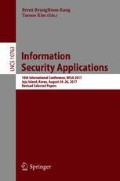Abstract
The shortest vector problem (SVP) and the shortest independent vectors problem (SIVP) are two famous problems in lattices, which are usually used to evaluate the hardness of some computational problems related to lattices. It is well known that the search-SVP is equivalent to its optimization version. However, it seems very difficult to prove the equivalence between search-SIVP and optimization-SIVP. In this paper, we revisit the Successive Minima Problem (SMP), which is proved the equivalence relation with SIVP. Naturally we will consider its optimization version as to find all successive minima of a given lattice, and finally we will prove that it is equivalent to its search version.
This work was supported in part by the NNSF of China (No. 61572490, and No. 11471314), the National Center for Mathematics and Interdisciplinary Sciences, CAS, and Science and Technology on Communication Security Laboratory (No. 9140C110301150C11051).
Access this chapter
Tax calculation will be finalised at checkout
Purchases are for personal use only
References
Ajtai, M.: Generating hard instances of lattice problems (extended abstract). In: Proceedings of the Twenty-Eighth Annual ACM Symposium on Theory of Computing, STOC 1996, pp. 99–108. ACM, New York (1996). https://doi.org/10.1145/237814.237838
Ajtai, M.: The shortest vector problem in L2 is NP-hard for randomized reductions (extended abstract). In: Proceedings of the Thirtieth Annual ACM Symposium on Theory of Computing, STOC 1998, pp. 10–19. ACM, New York (1998). https://doi.org/10.1145/276698.276705
Ajtai, M., Dwork, C.: A public-key cryptosystem with worst-case/average-case equivalence. In: Proceedings of the Twenty-Ninth Annual ACM Symposium on Theory of Computing, STOC 1997, pp. 284–293. ACM, New York (1997). https://doi.org/10.1145/258533.258604
Alkim, E., Bindel, N., Buchmann, J.A., Dagdelen, Ö., Schwabe, P.: TESLA: Tightly-Secure Efficient Signatures from Standard Lattices. IACR Cryptology ePrint Archive 2015, 755 (2015). https://eprint.iacr.org/2015/755.pdf
Blömer, J., Naewe, S.: Sampling methods for shortest vectors, closest vectors and successive minima. In: Arge, L., Cachin, C., Jurdziński, T., Tarlecki, A. (eds.) ICALP 2007. LNCS, vol. 4596, pp. 65–77. Springer, Heidelberg (2007). https://doi.org/10.1007/978-3-540-73420-8_8
Boas, P.V.E.: Another NP-complete problem and the complexity of computing short vectors in lattices. Mathematics Department Report 81-04. University of Amsterdam (1981)
Brakerski, Z., Vaikuntanathan, V.: Efficient fully homomorphic encryption from (standard) LWE. SIAM J. Comput. 43(2), 831–871 (2014). https://doi.org/10.1137/120868669
Cai, J.Y., Nerurkar, A.: Approximating the SVP to within a factor (1–1/dim\(^\epsilon \)) is NP-hard under randomized conditions. In: Proceedings of the Thirteenth Annual IEEE Conference on Computational Complexity (Formerly: Structure in Complexity Theory Conference) (Cat. No.98CB36247), pp. 46–55, June 1998
Ducas, L., Durmus, A., Lepoint, T., Lyubashevsky, V.: Lattice signatures and bimodal Gaussians. In: Canetti, R., Garay, J.A. (eds.) CRYPTO 2013. LNCS, vol. 8042, pp. 40–56. Springer, Heidelberg (2013). https://doi.org/10.1007/978-3-642-40041-4_3
Gentry, C.: Fully homomorphic encryption using ideal lattices. In: Proceedings of the Forty-First Annual ACM Symposium on Theory of Computing, STOC 2009, pp. 169–178. ACM, New York (2009). https://doi.org/10.1145/1536414.1536440
Gentry, C., Peikert, C., Vaikuntanathan, V.: Trapdoors for hard lattices and new cryptographic constructions. In: Proceedings of the Fortieth Annual ACM Symposium on Theory of Computing, STOC 2008, pp. 197–206. ACM, New York (2008). https://doi.org/10.1145/1374376.1374407
Goldreich, O., Micciancio, D., Safra, S., Seifert, J.P.: Approximating shortest lattice vectors is not harder than approximating closest lattice vectors 71, 55–61 (1999). http://www.sciencedirect.com/science/article/pii/S0020019099000836
Hoffstein, J., Howgrave-Graham, N., Pipher, J., Silverman, J.H., Whyte, W.: NTRUSign: digital signatures using the NTRU lattice. In: Joye, M. (ed.) CT-RSA 2003. LNCS, vol. 2612, pp. 122–140. Springer, Heidelberg (2003). https://doi.org/10.1007/3-540-36563-X_9
Hoffstein, J., Pipher, J., Silverman, J.H.: NTRU: a ring-based public key cryptosystem. In: Buhler, J.P. (ed.) ANTS 1998. LNCS, vol. 1423, pp. 267–288. Springer, Heidelberg (1998). https://doi.org/10.1007/BFb0054868
Horn, R.A., Johnson, C.R.: Matrix Analysis. Cambridge University Press, Cambridge (2012)
Hu, G., Pan, Y.: Improvements on reductions among different variants of SVP and CVP. In: Kim, Y., Lee, H., Perrig, A. (eds.) WISA 2013. LNCS, vol. 8267, pp. 39–51. Springer, Cham (2014). https://doi.org/10.1007/978-3-319-05149-9_3
Ipsen, I.C.F., Rehman, R.: Perturbation bounds for determinants and characteristic polynomials. SIAM J. Matrix Anal. Appl. 30(2), 762–776 (2008). https://doi.org/10.1137/070704770
Kannan, R.: Minkowski’s convex body theorem and integer programming. Math. Oper. Res. 12(3), 415–440 (1987). https://doi.org/10.1287/moor.12.3.415
Lyubashevsky, V., Micciancio, D.: Generalized compact knapsacks are collision resistant. In: Bugliesi, M., Preneel, B., Sassone, V., Wegener, I. (eds.) ICALP 2006. LNCS, vol. 4052, pp. 144–155. Springer, Heidelberg (2006). https://doi.org/10.1007/11787006_13
Lyubashevsky, V., Micciancio, D., Peikert, C., Rosen, A.: SWIFFT: a modest proposal for FFT hashing. In: Nyberg, K. (ed.) FSE 2008. LNCS, vol. 5086, pp. 54–72. Springer, Heidelberg (2008). https://doi.org/10.1007/978-3-540-71039-4_4
Micciancio, D.: Efficient reductions among lattice problems. In: Proceedings of the Nineteenth Annual ACM-SIAM Symposium on Discrete Algorithms, SODA 2008, pp. 84–93. Society for Industrial and Applied Mathematics, Philadelphia (2008). http://dl.acm.org/citation.cfm?id=1347082.1347092
Micciancio, D., Goldwasser, S.: Complexity of Lattice Problems: A Cryptographic Perspective. The Kluwer International Series in Engineering and Computer Science, vol. 671. Kluwer Academic Publishers, Boston (2002)
Peikert, C., Rosen, A.: Efficient collision-resistant hashing from worst-case assumptions on cyclic lattices. In: Halevi, S., Rabin, T. (eds.) TCC 2006. LNCS, vol. 3876, pp. 145–166. Springer, Heidelberg (2006). https://doi.org/10.1007/11681878_8
Piazza, G., Politi, T.: An upper bound for the condition number of a matrix in spectral norm. J. Comput. Appl. Math. 143(1), 141–144 (2002). http://www.sciencedirect.com/science/article/pii/S0377042702003965
Regev, O.: On lattices, learning with errors, random linear codes, and cryptography. In: Proceedings of the Thirty-Seventh Annual ACM Symposium on Theory of Computing, STOC 2005, pp. 84–93. ACM, New York (2005). https://doi.org/10.1145/1060590.1060603
Acknowledgement
We very thank the anonymous referees for their valuable suggestions on how to improve the presentation of this paper.
Author information
Authors and Affiliations
Corresponding author
Editor information
Editors and Affiliations
Rights and permissions
Copyright information
© 2018 Springer International Publishing AG, part of Springer Nature
About this paper
Cite this paper
Li, H., Pan, Y. (2018). The Search Successive Minima Problem Is Equivalent to Its Optimization Version. In: Kang, B., Kim, T. (eds) Information Security Applications. WISA 2017. Lecture Notes in Computer Science(), vol 10763. Springer, Cham. https://doi.org/10.1007/978-3-319-93563-8_4
Download citation
DOI: https://doi.org/10.1007/978-3-319-93563-8_4
Published:
Publisher Name: Springer, Cham
Print ISBN: 978-3-319-93562-1
Online ISBN: 978-3-319-93563-8
eBook Packages: Computer ScienceComputer Science (R0)

